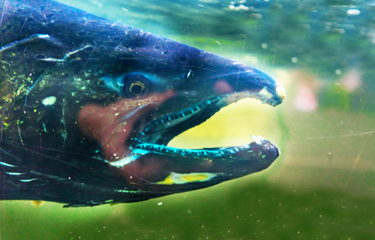A virus found in farmed salmon is being transmitted between net-pen salmon farms and wild juvenile chinook salmon in British Columbia waters, according to a new genomics analysis published in Science Advance.
The study traces the origins of piscine orthoreovirus (PRV) – associated with kidney and liver damage in chinook salmon – to Atlantic salmon farms in Norway, and found that the virus is now widespread in salmon farms in Canada’s province of British Columbia.
The collaborative, peer-reviewed study was done by the University of British Columbia and the Strategic Salmon Health Initiative, a partnership between Fisheries and Oceans Canada, Genome B.C., and the Pacific Salmon Foundation.
“There has been a lot of discussion about where PRV comes from,” the study’s lead author, Gideon Mordecai, who studies salmon viruses at the University of British Columbia, told Hakai Magazine. “There is this narrative that it is native to British Columbia and not a big deal, but I didn’t think that was right.”
Mordecai and his colleagues compared the genetic sequences of every available sample of the most common strain of the virus in the Pacific, PRV-1, from around the world and reconstructed the virus’s evolutionary history. The virus’ evolutionary tree confirmed that PRV was not native to the Pacific; It first arrived in the region just over 30 years ago, when local aquaculture efforts were just starting up. They found the variant of PRV prevalent in the Pacic Northwest U.S. to be substantially similar to that found in the northeast Atlantic. Both the timing and the genetic similarities suggest the virus was brought to the Pacific alongside imported Atlantic salmon eggs from Norwegian fish farms.
According to the study, the same virus variant has since spread to salmon farms in Chile.
Researchers started to screen wild chinook salmon for the virus, finding a a close association between their proximity to fish farms and the likelihood of infection.
The official position of Fisheries and Oceans Canada is that the strain of PRV found in the Pacific is its own unique strain, but in a statement said that the new research will feed into its future management of aquaculture and wild salmon populations.
“[This work] provides valuable information on the origin, evolution, and potential transmission dynamics of PRV-1a. The department will be considering these findings alongside additional studies on PRV in British Columbia’s coastal waters,” an agency statement said. “As new information becomes available, the department remains open to reviewing and incorporating the information as part of its adaptive management process.”
It is not clear how the introduction of the virus into wild Pacific salmon populations is affecting their survival and abundance. In farmed Atlantic salmon, PRV causes heart and skeletal muscle inflammation, which is not fatal but hinders the fish’s ability to swim and feed. This would obviously be an issue in wild stocks if affected similarly, as it would lead to higher competition for food and higher vulnerability to predators.
Some experts have written the study off as anti-aquaculture activism.
“As a board-certified veterinary pathologist, I disagree with the conclusion that PRV is now an important infectious agent in critically endangered wild Pacific salmon populations,” Gary Marty, a fish pathologist with the Animal Health Centre of B.C.’s Ministry of Agriculture, Food, and Fisheries, told SeaWestNews.
Marty claims that the earliest positive PRV test result in the region was from a wild-source steelhead trout sampled in 1977, which predates salmon farming in B.C.
“Even the thesis cited by the new paper reports only mild PRV-associated microscopic lesions among six of nine wild chinook salmon examined. The other three fish had no PRV-associated microscopic lesions,” he said. “Mild microscopic lesions are not a threat to wild salmon populations. Instead, mild lesions are part of the normal inflammatory response to infectious agents that wild fish encounter during their migrations.”
Hugh Mitchell, a Pacfic fish farming veteran and owner of AquaTactics Fish Health in Kirkland, Washington, USA, also spoke out against the study on Twitter, claiming that the paper’s authors “are an isolated group (not representative of the entire Canadian Department of Fisheries and Oceans who continually focus on activist research against aquaculture and ignore contradicting evidence.”
“Agriculture was necessary to lessen the impact on the environment while feeding humanity. Aquaculture does the same for the oceans,” he wrote. “We need to quit with this bickering and catch up with the rest of the world on the ‘blue revolution.’”
Photo courtesy of Bill Perry/Shutterstock







